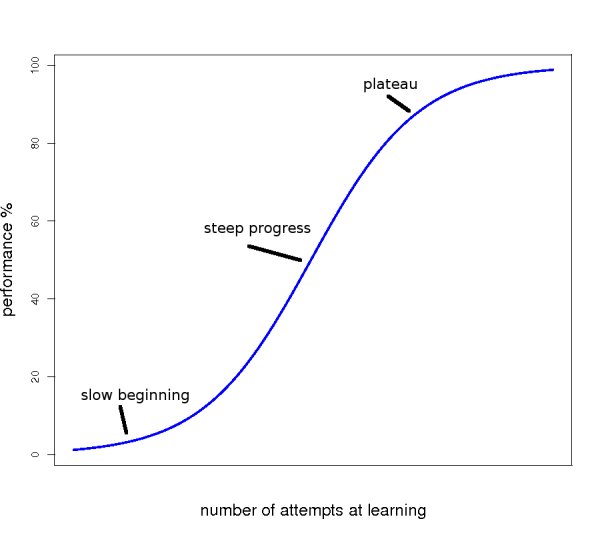The learning curve
In psychology the learning curve denotes a graphical representation of the rate at which you make progress learning new information.
When you learn something new repetition is essential. Through repetition you become more efficient and more effective at any challenge, which you pose yourself. The progress you make during the learning and repetition phases can be represented graphically like in the plot below. Scientific studies on memory and acquisition of motor skills have shown that the learning curve looks as follows: in the beginning, when what you have to learn is very new, the progress you make is very slow. However, if you keep training and repeating something interesting happens. Your brain starts adjusting to the challenge and suddenly the progress becomes much more accelerated. This is the phase, where you make the most progress. Once you reach a certain level of skill and knowledge you enter the phase of diminishing returns. The better you become at the task the less you still can make progress in the learning curve. You start mastering the new knowledge or skill and your brain has adapted and adjusted to the challenge – you hit the bounds of the skill or you know all there is to know in that field – you have reached a plateau. The plateau is generally not flat, it is just much, much harder to make significant progress. Most people then are satisfied with the results and say that they have learned the new knowledge or skill as well as it can be learned. You could call it the individual maximum competence for a given skill.

Most likely you have experienced the learning curve first hand. Whenever you delve into a new and very complex field your progress at the beginning of the learning curve is very slow. This is mostly due to the fact that you first have to familiarize yourself with the topic, get an overview what’s going on, understand the basic definitions and terminology etc.
Once you are over this initial phase, whatever you learn starts slowly making sense. In fact, once you learned the basic vocabulary, your understanding improves significantly and you make a lot of progress learning what really matters in that field. This is when all the scattered facts begin to interconnect and you start “putting it all together”. You continue making fast progress until you reached the end of what there is to learn in the given field and when all is left are the boring details, which do not change the big picture any more. Then your progress in the learning curve slows down until you reach your individual plateau.
The first scientific study of the learning curve was performed by Hermann Ebbinghaus. Ebbinghaus learned nonsensical three letter words such as “WID” “KOR” “ZIF” etc. and recorded his progress. He found that when learning lists of such nonsensical words the time spent learning a given number of words increases drastically with the number of words.
While the learning curve originally used in psychology and memory research has a clearly defined meaning, it has become increasingly popular in other fields as well. Therefore different terminologies have been coined such as “experience curve”, “progress function”, “progress curve”, “improvement curve”, “cost improvement curve”, “start-up curve”, and “efficiency curve”. These different names however denote essentially the same behavior. An slow beginning followed by an accelerated rate of increase and a subsequent reaching of a plateau. All these processes are described by a so called S-curve.
The steep learning curve
A colloquial term that is frequently used is “this product has a steep learning curve”. Interestingly this is exactly the opposite of the original definition. When you say e.g. “quantum thermodynamics has a steep learning curve” you intend to say that it is rather difficult to understand and master it. A steep learning curve however, as defined in learning psychology, means that you make rapid progress. This is the part in the middle of above plot where things are starting to make sense and you move ahead quickly – this is where learning is easiest!
Probably the term came to be because you can consider its figural meaning: if you hike on a learning curve, steep is probably associated with frustration and strenuous climbing. Not so!
Next time you hear somebody talk about a steep learning curve – just smile.


